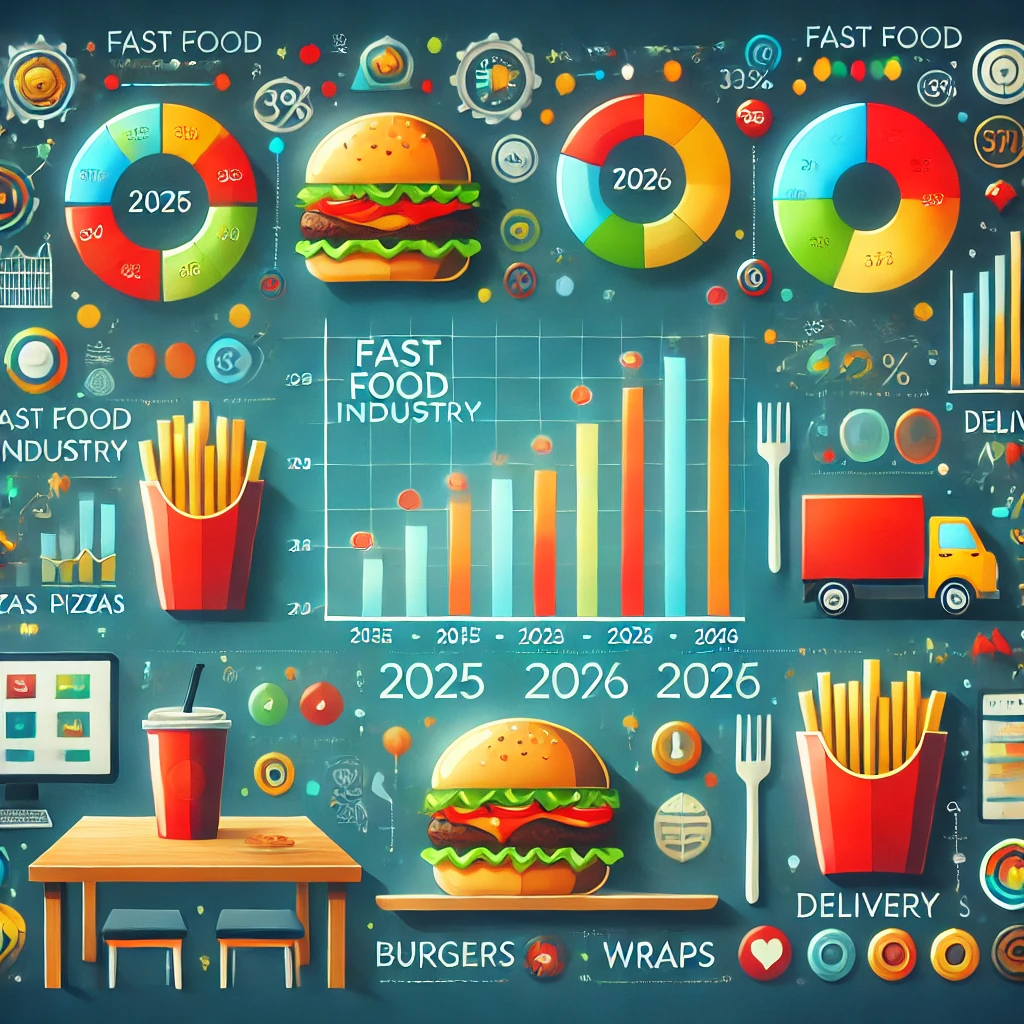Fast Food Industry Growth in India 2025-26
The fast food industry in India is experiencing significant growth, driven by factors such as rapid urbanization, changing consumer lifestyles, and increased disposable incomes. In 2024, the market was valued at approximately USD 18.6 billion and is projected to reach USD 35.5 billion by 2033, exhibiting a compound annual growth rate (CAGR) of 7.1% from 2025 to 2033.
Market Overview: Fast Food Industry Growth in India
India’s fast food sector is expanding at an impressive rate, fueled by rising disposable incomes, urban migration, and a younger demographic. The industry is expected to grow at a CAGR of over 10% in the coming years, making it one of the most lucrative segments in the food and beverage industry.
The fast food industry growths is further driven by the proliferation of international brands and the expansion of homegrown food chains. The broader foodservice market in India is also expanding, with an estimated size of USD 85.19 billion in 2025, expected to grow at a CAGR of 10.41% to reach USD 139.75 billion by 2030.
Quick Service Restaurants (QSRs) are a significant segment within the fast food industry. In 2024, the QSR market was valued at USD 25.46 billion and is anticipated to grow at a CAGR of 8.74%, reaching USD 38.71 billion by 2029.
Major international and domestic chains are contributing to this growth through aggressive expansion plans. For instance, Wow MOMO Foods, an Indian fast-food chain, plans to go public within two years and aims to expand its store count to 1,000, doubling its revenue to 10 billion rupees over the next 30 months.
Food delivery platforms are also experiencing substantial growth. Zomato, a leading Indian food delivery service, expects its meal delivery business to grow at an annual rate of 30% over the next five years, driven by rising demand from affluent and middle-class customers in India’s large cities.
Key Drivers of Fast Food Industry Growth
1. Urbanization & Busy Lifestyles
With more people moving to cities, the demand for quick, affordable, and tasty food options has surged. Many consumers prefer fast food due to their hectic work schedules, further boosting the fast food industry growth in India.
2. Rising Disposable Income
As incomes rise, people are spending more on dining out and food delivery services. This has led to a significant expansion of fast food chains across urban and semi-urban areas, contributing to the fast food industry growths.
3. Digital Transformation & Food Delivery Boom
Online food ordering platforms such as Zomato and Swiggy have revolutionized the industry. The ease of ordering food online and contactless payment options have played a crucial role in the fast food industry growths.
4. Expansion of Global & Local Fast Food Chains
Major international brands like McDonald’s, KFC, Domino’s, and Burger King are aggressively expanding their presence in India. At the same time, domestic fast food chains are growing by offering regional flavors, supporting the fast food industry growth.
5. Changing Consumer Preferences
Indian consumers are now open to experimenting with different cuisines, including American, Italian, and Chinese fast food. This shift in preferences is driving innovation and competition in the market, accelerating the fast food industry growth.
Emerging Trends in the Fast Food Industry Growth
1. Healthier Fast Food Options
Consumers are becoming more health-conscious, pushing brands to introduce healthier alternatives. Many fast food chains are now offering low-calorie, plant-based, and organic meal options to cater to this demand. This trend will significantly impact the fast food industry growth in the coming years.
2. Regional & Customized Menus
Localization has become a key strategy for global fast food brands. McDonald’s, for example, has introduced the McAloo Tikki burger specifically for Indian consumers. This localization trend is expected to contribute to fast food industry growth in India.
3. Sustainable & Eco-Friendly Practices
As sustainability becomes a priority, many fast food chains are adopting eco-friendly practices like biodegradable packaging, reducing food waste, and sourcing local ingredients. Sustainability initiatives will play a major role in the fast food industry growth in India.
4. Rise of Cloud Kitchens
Cloud kitchens, which operate without physical dine-in spaces, are growing rapidly. With lower operational costs and high-profit margins, cloud kitchens are driving the fast food industry growth by catering to the increasing demand for online food delivery.
5. Artificial Intelligence & Automation
AI-driven food ordering, automated kitchens, and robotic cooking are revolutionizing the fast food industry. Many brands are leveraging technology to enhance efficiency and customer experience, further accelerating fast food industry growth.
Challenges in the Fast Food Industry Growth
Despite its rapid expansion, the fast food industry faces several challenges:
1. Rising Health Concerns
Fast food is often associated with obesity and lifestyle diseases. The increasing awareness of healthy eating may pose a challenge to fast food industry growth unless brands adapt by offering healthier options.
2. High Competition
The market is becoming highly competitive, with both global giants and local brands competing for dominance. Innovation and marketing will be crucial for sustaining fast food industry growths.
3. Regulatory & Food Safety Compliance
Government regulations on food safety, hygiene, and taxation impact the operations of fast food chains. Adhering to stringent compliance norms is necessary for ensuring fast food industry growth.
4. Cost Fluctuations & Supply Chain Issues
The prices of raw materials, transportation costs, and supply chain disruptions can affect profitability. Efficient cost management will be key to sustaining fast food industry growth in India.
Future of Fast Food Industry Growth in India
The future of the fast food industry in India looks promising, with immense growth potential. The expansion of QSR (Quick Service Restaurant) chains, cloud kitchens, and innovative food technology will drive fast food industry growths further. Brands that prioritize customer experience, sustainability, and innovation will dominate the market in 2025-26.
Conclusion
The fast food industry growths in India is expected to reach new heights in 2025-26, driven by urbanization, digitalization, and evolving consumer preferences. While challenges exist, opportunities for innovation, sustainability, and market expansion will shape the industry’s future. Businesses that adapt to changing trends and consumer demands will thrive in this fast-evolving market.
By focusing on quality, convenience, and innovation, the fast food industry growths in India will continue to flourish, making it a key sector in the country’s economic landscape.

